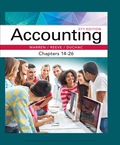
Concept explainers
Ethics in Action
Lucas Hunter, president of Simmons Industries Inc., believes that reporting operating cash flow per share on the income statement would be a useful addition to the company’s just completed financial statements. The following discussion took place between Lucas Hunter and Simmons' controller, John Jameson, in January, after the close of the fiscal year:
Lucas: I’ve been reviewing our financial statements for the last year. I am disappointed that our net income per share has dropped by 10% from last year. This won't look good to our shareholders. Is there anything we can do about this?
John. What do you means? The past is the past, and the numbers are in. There isn’t much that can be done about it Our financial statements were prepared according to generally accepted accounting principles, and I don’t see much leeway for significant change at this point.
Lucan No, no. I’ve not suggesting that we “cook the books”. But look at the cash flow from operating activities on the statement of
John. Well, the cash flow from operating activities is on the statement of cash flows, so I guess users will be able to see the improved cash flow figures there
Lucas: This is true, but somehow I think this information should be given a much higher profile. I don't like this information being “buried” in the statement of cash flows. You know as well as I do that many users will focus on the income statement Therefore. I think we ought to include an operating cash flow per share number on the face of the income statement—someplace under the earnings per share number In this way, users will get the complete picture of our operating performance. Yes, our earnings per share dropped this year, but our cash flow from operating activities improved! And all the information is in one place where users can see and compare the figures. What do you think?
John I've never really thought about it like that before I guess we could put the operating cash flow per share on the income statement, underneath the earnings per share amount. Users would really benefit from this disclosure. Thanks for the idea—I'll start working on it.
Lucas: Glad to be of service.
How would you interpret this situation? Is John behaving in an ethical and professional manner?
Trending nowThis is a popular solution!

Chapter 16 Solutions
Accounting, Chapters 14-26
 Financial AccountingAccountingISBN:9781337272124Author:Carl Warren, James M. Reeve, Jonathan DuchacPublisher:Cengage LearningPrinciples of Accounting Volume 1AccountingISBN:9781947172685Author:OpenStaxPublisher:OpenStax College
Financial AccountingAccountingISBN:9781337272124Author:Carl Warren, James M. Reeve, Jonathan DuchacPublisher:Cengage LearningPrinciples of Accounting Volume 1AccountingISBN:9781947172685Author:OpenStaxPublisher:OpenStax College Survey of Accounting (Accounting I)AccountingISBN:9781305961883Author:Carl WarrenPublisher:Cengage Learning
Survey of Accounting (Accounting I)AccountingISBN:9781305961883Author:Carl WarrenPublisher:Cengage Learning- Principles of Accounting Volume 2AccountingISBN:9781947172609Author:OpenStaxPublisher:OpenStax College
 Financial AccountingAccountingISBN:9781305088436Author:Carl Warren, Jim Reeve, Jonathan DuchacPublisher:Cengage Learning
Financial AccountingAccountingISBN:9781305088436Author:Carl Warren, Jim Reeve, Jonathan DuchacPublisher:Cengage Learning





